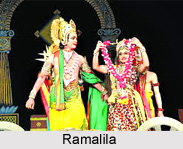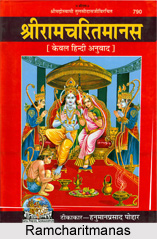 Devotional drama in Hindi language has been a major part of the theatre culture in the northern part of India, especially in the Indian state of Uttar Pradesh. Two folk traditions of religious drama, the Ramlila and Raslila, developed in North India some time before the secular Swang. Dedicated to the sectarian deities of Lord Rama and Lord Krishna, the Lila theatres likely originated with impersonations of the gods at annual festivals. Their current forms date from the Bhakti period of Hindi literature, when vernacular devotional poetry found a home in the hearts of the Hindu population. The Lila dramas wed episodic enactment of the lives of Lord Rama and Krishna with the singing, dancing, and recitation of poems from this newly flowered literature.
Devotional drama in Hindi language has been a major part of the theatre culture in the northern part of India, especially in the Indian state of Uttar Pradesh. Two folk traditions of religious drama, the Ramlila and Raslila, developed in North India some time before the secular Swang. Dedicated to the sectarian deities of Lord Rama and Lord Krishna, the Lila theatres likely originated with impersonations of the gods at annual festivals. Their current forms date from the Bhakti period of Hindi literature, when vernacular devotional poetry found a home in the hearts of the Hindu population. The Lila dramas wed episodic enactment of the lives of Lord Rama and Krishna with the singing, dancing, and recitation of poems from this newly flowered literature.
The Lord Ramalila is based upon adventures of Lord Rama written by Tulsidas in Ramcharitmanas, a long poem composed in the Awadhi dialect. Chanted passages from Tulsidas`s text intersperse with song and dance of Lord Rama to explicate the story. This form of Ramalila began soon after Tulsidas`s death in 1624 and, according to legend, was first enacted by his disciple Megha Bhagat. In the nineteenth century the royal house of Varanasi undertook sponsorship of the Ramlila at Ramnagar on a massive scale employing large numbers of actors and specific locations in the city to represent the story`s geographical settings.
This grand lila is performed over a period of days, culminating in the festival of Dashahara, when Lord Rama finally defeats the forces of evil. It is attended by hundreds of thousands of spectators who follow the procession as an itinerant audience of worshipers. Whereas the most famous Ramlila is linked with the geography and people of Varanasi, the Raslila`s homeland is Vrindavan and the Braj area, where pilgrims come to worship Lord Krishna, born among its simple village people. Temple courtyards and pavilions form stages for dozens of Ras Lila shows held every year at Krishna`s birthday. The performances are bipartite, comprising circle dances (ras) by boys playing female devotees (gopis) and dramatic episodes (lilas) from Lord Krishna`s life. As foci of religious emotion and musical embellishment, the verses of poets like Surdas and Nanddas, written in the Braj bhasha, punctuate these incidents. The Ras Lila may have achieved this form as early as the sixteenth century.

Alongside these celebrated Lilas, scores of less elaborate representations of the Lord Rama and Lord Krishna stories are performed by wandering Ramlila companies and residents of city neighbourhoods. The artists who play in these rustic shows are not dogmatic about the difference between devotion and entertainment, and the deity`s story is intermixed with much singing, dancing, and comic improvisation. These folk lilas provide an important avenue of access, to devotional Hinduism for people all over northern India.
The Lila theatres, particularly in their village and neighbourhood forms, established a practice of popularising teaching and stories of Lord Rama that, in a general sense, created a foundation for the later Swang and Nautanki. Common conventions such as open-air performance use of music and dance, and mythological story material link these theatres, but a more explicit genetic relationship at the regional level is difficult to verify.
Indeed, a set of contrasts distinguishes the theatre of devotion from its secular counterpart. On the one hand, the Lila plays are meant to inspire reverence and love for God, and they often produce audience emotion approaching rapture; the actors, prepubescent Brahmin boys, are worshiped as divine incarnations (Swarup). On the other hand, Swang and Nautanki shows evoke merriment, lust, wonder, even fear; their performers are considered outcastes and prostitutes. The Lilas function within a religious matrix presided over by priests, patrons, and high-status interpreters. Nautanki relies on its commercial appeal, offering diversion in exchange for a price. The language of the Lilas is elevated and literary, whereas Nautanki is composed in the spoken tongue, accessible to all.




















